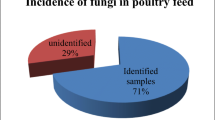Abstract
We have studied the aflatoxin producing capacity of 41 Aspergillus flavus strains isolated from the mycoflora present of natural media (wheat, rice and mixed feed) synthetic medium (Aflatoxin Producing Ability Medium) and semisynthetic media (Coconut Agar Medium and Glucose Yeast Extract Agar) were compared. Aflatoxins were analysed on days 4 and 8 post-inoculation under an incubation temperature of 28 °C. A total of 30 strains (75.7%) were producers on natural media as detected by Thin Layer Chromatography: 23 strains on wheat, 27 on rice and 12 on mixed feed. The results by qualitative flourescence tests on synthetic and semisynthetic media were: 3 strains positive on Coconut Agar Medium (CAM) 1 on Glucose Yeast Extract Agar (GY + Agar) and none on Aflatoxin Producing Ability Medium (APA).
Similar content being viewed by others
References
Cutuli MT, Mateos A, Paya MJ, Camara JM, Suarez G. Estudio comparativeo y evolucion de la micoflora presente en tres tipos de piensos para truchas. Rev Iber Micol 1986; 3: 77–84.
Filtenberg O, Frisvad JC. A simple screening method for toxicogenic moulds in pure cultures. Lebensm Wiss Technol 1980; 13: 128–30.
Gimeno A. Thin layer chromatography determination of aflatoxins, ochratoxins, sterigmatocystin, zearalenone, citrinin, T-2 toxin, diacetoxyscirpenol, penicillic acid, patulin and penitrem. J Ass Off Anal Chem 1979; 62: 579–85.
Hara S, Fennell DI, Hesseltine CW. Aflatoxin-producing strains of Aspergillus flams detected by fluorescence of agar medium under ultraviolet light. Appl Microbiol 1974; 27: 1118–23.
Jesenka Z, Poster M, Matayasova J, Polakova O. Collaborative study of the effectiveness of the screening test on APA medium for aflatoxin producing Aspergilli. Zbl Bakt Hyg I Abt Orig B 1980; 171: 408–15.
Lin MT, Dianesse JC. A coconut agar medium for rapid detection of aflatoxin production by Aspergillus spp. Phytopathology 1976; 66: 1466–9.
Moreno MA, Suarez G. Aflatoxin production potential of Aspergillus flavus strains from Spanish poultry feeds. Mycopathologia 1986; 95: 129–32.
Moreno MA, Ramos MC, Suarez G. A rapid extraction method for detecting aflatoxin producing isolates. Myotoxin Res 1987; 3: 33–5.
Prasad T, Thakur MK, Prasad RB, Sahay M. Aflatoxin contamination in wheat. Biol Bull India 1982; 4(2): 107–8.
Sanchis V, Viñas I, Jimenez M, Hernandez E. Deteccion rápida de cepas de Aspergillus flavus productoras de aflatoxinas. Rev Agroquim Tecnol Aliment 1983; 23: 54–9.
Sanchis V, Sala N, Palomes A, Santamaria P, Burdaspal A. Occurrence of aflatoxin and aflatoxigenic molds in foods and feed in Spain. J Food Prot 1986; 49(6): 445–8.
Sinnhuber RO. Aflatoxin in cottonseed meal and liver cancer in rainbow trout. Res Rept 1967; 70: 48–55.
Wicklow DT, Shotwell OL, Gordon LA. Use of aflatoxin ability medium to distinguish aflatoxin-producing strains of Aspergillus flavus. Appl Envir Microbiol 1981; 41(3) 697–9.
Author information
Authors and Affiliations
Rights and permissions
About this article
Cite this article
Cutuli, M.T., Cuellar, A., Camara, J.M. et al. Different media and methodologies for the detection of aflatoxin production by Aspergillus flavus strains isolated from trout feed. Mycopathologia 113, 121–125 (1991). https://doi.org/10.1007/BF00442423
Received:
Accepted:
Issue Date:
DOI: https://doi.org/10.1007/BF00442423




